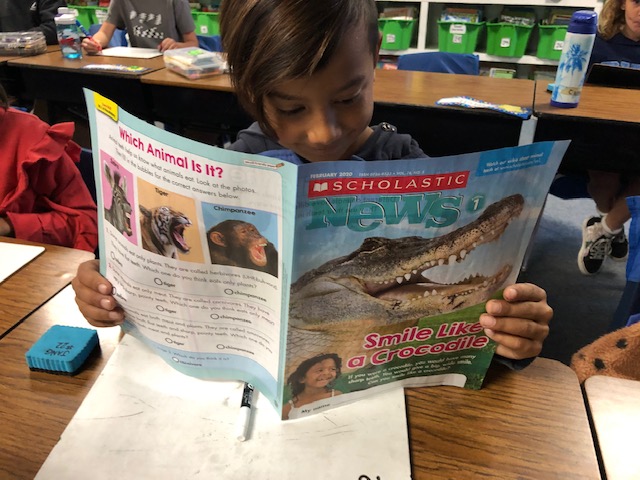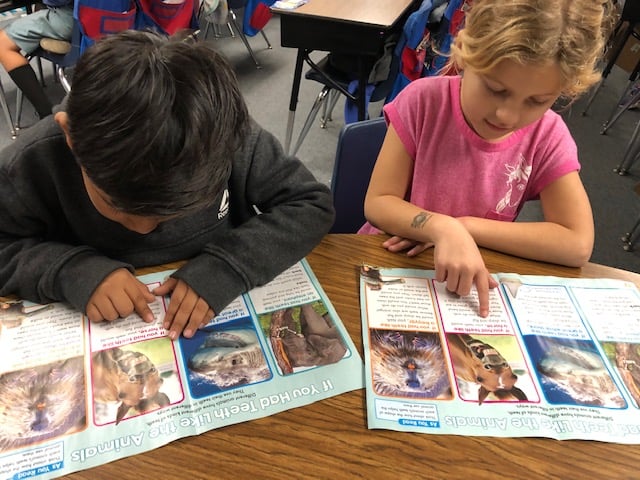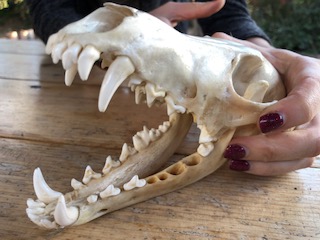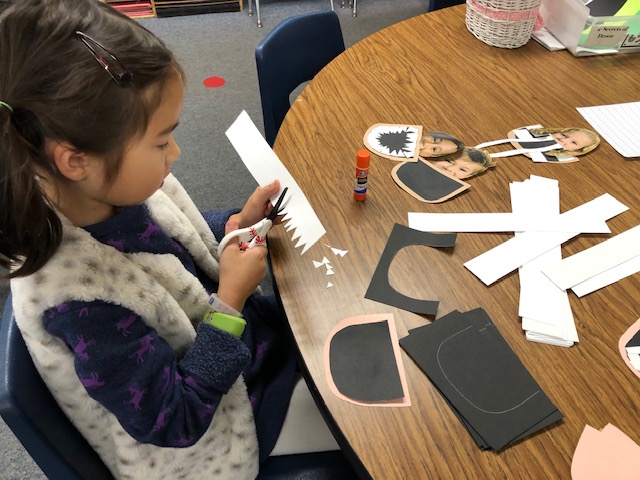
A Lesson on Animal Teeth That Mixes Reading, Writing and Science!
My first graders wish they had shark teeth!
By Nancy Jang
Grade: 1
Source: Scholastic News Grade 1


Key Takeways:
- Use an anchor chart to record what kids already know about animal teeth, then read Scholastic News for grade 1 and watch a video to learn more.
- Read What If You Had Animal Teeth, a funny book from which kids learn about animal teeth by imagining they have them!
- Have kids vote on their favorite teeth and make a graph to show how they voted. Then, they can write an opinion piece and make a craft based on their favorite
My first-grade kids are constantly showing off their wiggly baby teeth, and almost every day, a child loses a tooth in my classroom. That’s why I knew the February issue of Scholastic News for grade 1 about animal teeth would be a hit.

This issue really helped me build a lesson that kids could really sink their teeth into! You can try it too! Here are the steps:
- Create an Anchor Chart of What Kids Already Know
Before we read, we meet on the carpet and create an anchor chart to brainstorm what we know—or think we know—about animal teeth.
When one child said, “They can bite people,” another kid shouted out, “That’s not nice!”

- Read the Issue, Then Take Notes
Next, we read the issue of Scholastic News. I let kids read with partners or independently.
Then, we used the read-aloud feature on the Scholastic News website to listen to the issue read out loud.

Next, we re-read the issue using this notetaking page, “Compare Animal Teeth.” My kids learned that each category of animal has a different type of teeth depending on what they eat. We learned the definitions of carnivore and herbivore and how their teeth differ. The children also chose one animal to focus on for their note-taking and writing. They could choose from elephant, shark, beaver or zebra/horse as a topic for their notes and writing.
- Watch the Video!
Then we watched the video and added to our notes. The video is fun, informative and short! Perfect for the five minutes in between transitions or at the end of the day. We watched it twice—the first time just to enjoy it, and then a second time to catch any details to add to our notes.
- Look at Real Animal Teeth
Before the lesson, I had gone to our local nature center to see their animal skull collections. You can borrow these to use in your classroom. Since I couldn’t schedule that in time, I took pictures of the animal skulls to show the kids. We tried to predict what the animals ate based on looking at their teeth. There was a bobcat, a bear, a deer and a coyote skull.

One child looked at the photos and exclaimed, "It's dinosaur bones!" I had to explain to them that they are bones and dinosaurs have bones, but these are from animals that live in our local area now, and the skulls are not that old.
- Read the Funny and Informative Book What If You Had Animal Teeth
Next, I read What If You Had Animal Teeth by Sandra Markle. In this book, the author talks in detail about animals’ teeth.

I only chose to read aloud the sections on the elephant, shark, beaver and zebra. My students laughed at the cartoon pictures of the kids with animal teeth doing everyday things. The shark photo really grabbed their attention! Some kids started shouting everything they knew about sharks, and others were just staring at the photo. Just thinking about how much money you could make from the tooth fairy if you had all those teeth won over A LOT of kids who thought that shark teeth were the best.
Then we voted on which teeth we liked best. The shark won with nine votes. We made some math connections by analyzing the graph using our math words, and that helped launch us into our writing.

- Have Kids Write Opinion Pieces—Which Teeth Are Best?
My firsties are practicing opinion writing, so I asked them to write about why they voted as they did. One child wrote, “If I had to pick an animal's teeth to have, I would pick to have a shark’s teeth because I like to eat fish. Also, I like the ocean, and I would be rich from tooth fairy money.”
Another child wrote that she would choose to have a giraffe's teeth because she is a vegetarian and a giraffe is an herbivore and doesn't like to eat meat. And, she wrote, “Giraffes are cute, like me.”
- Make a Craft Based on the Book
I love putting up a bulletin board of my students’ writing, and I normally include a craft to mount with the students’ work. In this case, I used a photo of each student, and had the students create mouths and teeth with construction paper to add to their photos.

I hope you enjoyed taking a peek into my classroom to see how I used Scholastic News for grade 1 to teach writing!
Nancy Jang teaches first grade in the Newport Mesa Unified School District in Costa Mesa, California.
Key Takeways:
- Use an anchor chart to record what kids already know about animal teeth, then read Scholastic News for grade 1 and watch a video to learn more.
- Read What If You Had Animal Teeth, a funny book from which kids learn about animal teeth by imagining they have them!
- Have kids vote on their favorite teeth and make a graph to show how they voted. Then, they can write an opinion piece and make a craft based on their favorite
My first-grade kids are constantly showing off their wiggly baby teeth, and almost every day, a child loses a tooth in my classroom. That’s why I knew the February issue of Scholastic News for grade 1 about animal teeth would be a hit.

This issue really helped me build a lesson that kids could really sink their teeth into! You can try it too! Here are the steps:
- Create an Anchor Chart of What Kids Already Know
Before we read, we meet on the carpet and create an anchor chart to brainstorm what we know—or think we know—about animal teeth.
When one child said, “They can bite people,” another kid shouted out, “That’s not nice!”

- Read the Issue, Then Take Notes
Next, we read the issue of Scholastic News. I let kids read with partners or independently.
Then, we used the read-aloud feature on the Scholastic News website to listen to the issue read out loud.

Next, we re-read the issue using this notetaking page, “Compare Animal Teeth.” My kids learned that each category of animal has a different type of teeth depending on what they eat. We learned the definitions of carnivore and herbivore and how their teeth differ. The children also chose one animal to focus on for their note-taking and writing. They could choose from elephant, shark, beaver or zebra/horse as a topic for their notes and writing.
- Watch the Video!
Then we watched the video and added to our notes. The video is fun, informative and short! Perfect for the five minutes in between transitions or at the end of the day. We watched it twice—the first time just to enjoy it, and then a second time to catch any details to add to our notes.
- Look at Real Animal Teeth
Before the lesson, I had gone to our local nature center to see their animal skull collections. You can borrow these to use in your classroom. Since I couldn’t schedule that in time, I took pictures of the animal skulls to show the kids. We tried to predict what the animals ate based on looking at their teeth. There was a bobcat, a bear, a deer and a coyote skull.

One child looked at the photos and exclaimed, "It's dinosaur bones!" I had to explain to them that they are bones and dinosaurs have bones, but these are from animals that live in our local area now, and the skulls are not that old.
- Read the Funny and Informative Book What If You Had Animal Teeth
Next, I read What If You Had Animal Teeth by Sandra Markle. In this book, the author talks in detail about animals’ teeth.

I only chose to read aloud the sections on the elephant, shark, beaver and zebra. My students laughed at the cartoon pictures of the kids with animal teeth doing everyday things. The shark photo really grabbed their attention! Some kids started shouting everything they knew about sharks, and others were just staring at the photo. Just thinking about how much money you could make from the tooth fairy if you had all those teeth won over A LOT of kids who thought that shark teeth were the best.
Then we voted on which teeth we liked best. The shark won with nine votes. We made some math connections by analyzing the graph using our math words, and that helped launch us into our writing.

- Have Kids Write Opinion Pieces—Which Teeth Are Best?
My firsties are practicing opinion writing, so I asked them to write about why they voted as they did. One child wrote, “If I had to pick an animal's teeth to have, I would pick to have a shark’s teeth because I like to eat fish. Also, I like the ocean, and I would be rich from tooth fairy money.”
Another child wrote that she would choose to have a giraffe's teeth because she is a vegetarian and a giraffe is an herbivore and doesn't like to eat meat. And, she wrote, “Giraffes are cute, like me.”
- Make a Craft Based on the Book
I love putting up a bulletin board of my students’ writing, and I normally include a craft to mount with the students’ work. In this case, I used a photo of each student, and had the students create mouths and teeth with construction paper to add to their photos.

I hope you enjoyed taking a peek into my classroom to see how I used Scholastic News for grade 1 to teach writing!
Nancy Jang teaches first grade in the Newport Mesa Unified School District in Costa Mesa, California.
Key Takeways:
- Use an anchor chart to record what kids already know about animal teeth, then read Scholastic News for grade 1 and watch a video to learn more.
- Read What If You Had Animal Teeth, a funny book from which kids learn about animal teeth by imagining they have them!
- Have kids vote on their favorite teeth and make a graph to show how they voted. Then, they can write an opinion piece and make a craft based on their favorite
My first-grade kids are constantly showing off their wiggly baby teeth, and almost every day, a child loses a tooth in my classroom. That’s why I knew the February issue of Scholastic News for grade 1 about animal teeth would be a hit.

This issue really helped me build a lesson that kids could really sink their teeth into! You can try it too! Here are the steps:
- Create an Anchor Chart of What Kids Already Know
Before we read, we meet on the carpet and create an anchor chart to brainstorm what we know—or think we know—about animal teeth.
When one child said, “They can bite people,” another kid shouted out, “That’s not nice!”

- Read the Issue, Then Take Notes
Next, we read the issue of Scholastic News. I let kids read with partners or independently.
Then, we used the read-aloud feature on the Scholastic News website to listen to the issue read out loud.

Next, we re-read the issue using this notetaking page, “Compare Animal Teeth.” My kids learned that each category of animal has a different type of teeth depending on what they eat. We learned the definitions of carnivore and herbivore and how their teeth differ. The children also chose one animal to focus on for their note-taking and writing. They could choose from elephant, shark, beaver or zebra/horse as a topic for their notes and writing.
- Watch the Video!
Then we watched the video and added to our notes. The video is fun, informative and short! Perfect for the five minutes in between transitions or at the end of the day. We watched it twice—the first time just to enjoy it, and then a second time to catch any details to add to our notes.
- Look at Real Animal Teeth
Before the lesson, I had gone to our local nature center to see their animal skull collections. You can borrow these to use in your classroom. Since I couldn’t schedule that in time, I took pictures of the animal skulls to show the kids. We tried to predict what the animals ate based on looking at their teeth. There was a bobcat, a bear, a deer and a coyote skull.

One child looked at the photos and exclaimed, "It's dinosaur bones!" I had to explain to them that they are bones and dinosaurs have bones, but these are from animals that live in our local area now, and the skulls are not that old.
- Read the Funny and Informative Book What If You Had Animal Teeth
Next, I read What If You Had Animal Teeth by Sandra Markle. In this book, the author talks in detail about animals’ teeth.

I only chose to read aloud the sections on the elephant, shark, beaver and zebra. My students laughed at the cartoon pictures of the kids with animal teeth doing everyday things. The shark photo really grabbed their attention! Some kids started shouting everything they knew about sharks, and others were just staring at the photo. Just thinking about how much money you could make from the tooth fairy if you had all those teeth won over A LOT of kids who thought that shark teeth were the best.
Then we voted on which teeth we liked best. The shark won with nine votes. We made some math connections by analyzing the graph using our math words, and that helped launch us into our writing.

- Have Kids Write Opinion Pieces—Which Teeth Are Best?
My firsties are practicing opinion writing, so I asked them to write about why they voted as they did. One child wrote, “If I had to pick an animal's teeth to have, I would pick to have a shark’s teeth because I like to eat fish. Also, I like the ocean, and I would be rich from tooth fairy money.”
Another child wrote that she would choose to have a giraffe's teeth because she is a vegetarian and a giraffe is an herbivore and doesn't like to eat meat. And, she wrote, “Giraffes are cute, like me.”
- Make a Craft Based on the Book
I love putting up a bulletin board of my students’ writing, and I normally include a craft to mount with the students’ work. In this case, I used a photo of each student, and had the students create mouths and teeth with construction paper to add to their photos.

I hope you enjoyed taking a peek into my classroom to see how I used Scholastic News for grade 1 to teach writing!
Nancy Jang teaches first grade in the Newport Mesa Unified School District in Costa Mesa, California.
